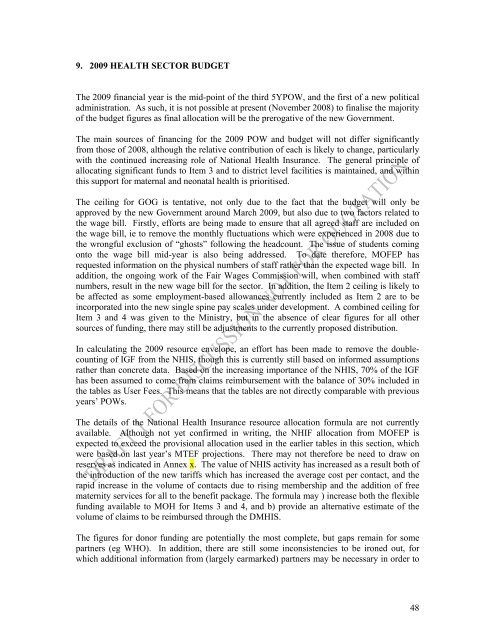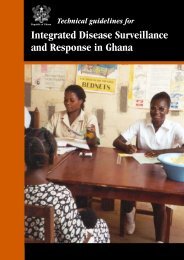Annual Programme of Work 2009 - Ministry of Health
Annual Programme of Work 2009 - Ministry of Health
Annual Programme of Work 2009 - Ministry of Health
You also want an ePaper? Increase the reach of your titles
YUMPU automatically turns print PDFs into web optimized ePapers that Google loves.
9. <strong>2009</strong> HEALTH SECTOR BUDGET<br />
The <strong>2009</strong> financial year is the mid-point <strong>of</strong> the third 5YPOW, and the first <strong>of</strong> a new political<br />
administration. As such, it is not possible at present (November 2008) to finalise the majority<br />
<strong>of</strong> the budget figures as final allocation will be the prerogative <strong>of</strong> the new Government.<br />
The main sources <strong>of</strong> financing for the <strong>2009</strong> POW and budget will not differ significantly<br />
from those <strong>of</strong> 2008, although the relative contribution <strong>of</strong> each is likely to change, particularly<br />
with the continued increasing role <strong>of</strong> National <strong>Health</strong> Insurance. The general principle <strong>of</strong><br />
allocating significant funds to Item 3 and to district level facilities is maintained, and within<br />
this support for maternal and neonatal health is prioritised.<br />
The ceiling for GOG is tentative, not only due to the fact that the budget will only be<br />
approved by the new Government around March <strong>2009</strong>, but also due to two factors related to<br />
the wage bill. Firstly, efforts are being made to ensure that all agreed staff are included on<br />
the wage bill, ie to remove the monthly fluctuations which were experienced in 2008 due to<br />
the wrongful exclusion <strong>of</strong> “ghosts” following the headcount. The issue <strong>of</strong> students coming<br />
onto the wage bill mid-year is also being addressed. To date therefore, MOFEP has<br />
requested information on the physical numbers <strong>of</strong> staff rather than the expected wage bill. In<br />
addition, the ongoing work <strong>of</strong> the Fair Wages Commission will, when combined with staff<br />
numbers, result in the new wage bill for the sector. In addition, the Item 2 ceiling is likely to<br />
be affected as some employment-based allowances currently included as Item 2 are to be<br />
incorporated into the new single spine pay scales under development. A combined ceiling for<br />
Item 3 and 4 was given to the <strong>Ministry</strong>, but in the absence <strong>of</strong> clear figures for all other<br />
sources <strong>of</strong> funding, there may still be adjustments to the currently proposed distribution.<br />
In calculating the <strong>2009</strong> resource envelope, an effort has been made to remove the doublecounting<br />
<strong>of</strong> IGF from the NHIS, though this is currently still based on informed assumptions<br />
rather than concrete data. Based on the increasing importance <strong>of</strong> the NHIS, 70% <strong>of</strong> the IGF<br />
has been assumed to come from claims reimbursement with the balance <strong>of</strong> 30% included in<br />
the tables as User Fees. This means that the tables are not directly comparable with previous<br />
years’ POWs.<br />
The details <strong>of</strong> the National <strong>Health</strong> Insurance resource allocation formula are not currently<br />
available. Although not yet confirmed in writing, the NHIF allocation from MOFEP is<br />
expected to exceed the provisional allocation used in the earlier tables in this section, which<br />
were based on last year’s MTEF projections. There may not therefore be need to draw on<br />
reserves as indicated in Annex x. The value <strong>of</strong> NHIS activity has increased as a result both <strong>of</strong><br />
the introduction <strong>of</strong> the new tariffs which has increased the average cost per contact, and the<br />
rapid increase in the volume <strong>of</strong> contacts due to rising membership and the addition <strong>of</strong> free<br />
maternity services for all to the benefit package. The formula may ) increase both the flexible<br />
funding available to MOH for Items 3 and 4, and b) provide an alternative estimate <strong>of</strong> the<br />
volume <strong>of</strong> claims to be reimbursed through the DMHIS.<br />
The figures for donor funding are potentially the most complete, but gaps remain for some<br />
partners (eg WHO). In addition, there are still some inconsistencies to be ironed out, for<br />
which additional information from (largely earmarked) partners may be necessary in order to<br />
48















